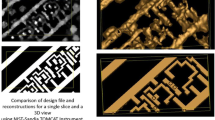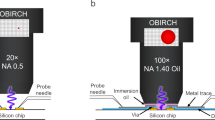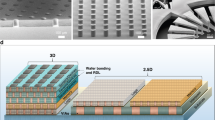Abstract
The imaging of integrated circuits across different length scales is required for failure analysis, design validation and quality control. At present, such inspection is accomplished using a hierarchy of different probes, from optical microscopy on the millimetre length scale to electron microscopy on the nanometre scale. Here we show that ptychographic X-ray laminography can provide non-destructive, three-dimensional views of integrated circuits, yielding both images of an entire chip volume and high-resolution images of arbitrarily chosen subregions. We demonstrate the approach using chips produced with 16 nm fin field-effect transistor technology, achieving a reconstruction resolution of 18.9 nm, and compare our results with photolithographic mask layout files and more conventional imaging approaches such as scanning electron microscopy. The technique should also be applicable to other branches of science and engineering where three-dimensional X-ray images of planar samples are required.
This is a preview of subscription content, access via your institution
Access options
Access Nature and 54 other Nature Portfolio journals
Get Nature+, our best-value online-access subscription
$29.99 / 30 days
cancel any time
Subscribe to this journal
Receive 12 digital issues and online access to articles
$119.00 per year
only $9.92 per issue
Buy this article
- Purchase on Springer Link
- Instant access to full article PDF
Prices may be subject to local taxes which are calculated during checkout




Similar content being viewed by others
Data availability
The aligned laminography projections generated during the current study are available under the Creative Common license in the Zenodo repository, https://doi.org/10.5281/zenodo.2657340.
References
Behrens, T. E. J. & Sporns, O. Human connectomics. Curr. Opin. Neurobiol. 22, 144–153 (2012).
Shahmoradian, S. et al. Three-dimensional imaging of biological tissue by cryo X-ray ptychography. Sci. Rep. 7, 6291 (2017).
Servanton, G. et al. Advanced TEM characterization for the development of 28-14 nm nodes based on fully-depleted silicon-on-insulator technology. J. Phys.Conf. Ser. 471, 01202 (2013).
Gignac, L. M. et al. High energy BSE/SE/STEM imaging of 8 um thick semiconductor interconnects. Microsc. Microanal. 20(S3), 8–9 (2014).
Holler, M. et al. High-resolution non-destructive three-dimensional imaging of integrated circuits. Nature 543, 402 (2017).
Orji, N. G. et al. Metrology for the next generation of semiconductor devices. Nat. Electron. 1, 532–547 (2018).
Robertson, J. & Riley, M. The big hack: how China used a tiny chip to infiltrate U.S. companies. Bloomberg Businessweek https://www.bloomberg.com/2018-the-big-hack (2018).
Pfeiffer, F. X-ray ptychography. Nat. Photonics 12, 9–17 (2018).
Hasenkamp, F. A. Radiographic laminography. Mater. Eval. 32, 169 (1974).
Helfen, L. et al. High-resolution three-dimensional imaging of flat objects by synchrotron-radiation computed laminography. Appl. Phys. Lett. 86, 071915 (2005).
Helfen, L. et al. Synchrotron-radiation computed laminography for high-resolution three-dimensional imaging of flat devices. Phys. Status Solidi A 204, 2760–2765 (2007).
Xu, F. et al. Correlative nanoscale 3D imaging of structure and composition in extended objects. PLoS ONE 7, 6 (2012).
Holler, M. & Raabe, J. Error motion compensating tracking interferometer for the position measurement of objects with rotational degree of freedom. Opt. Eng. 54, 054101 (2015).
Holler, M. et al. An instrument for 3D x-ray nanoimaging. Rev. Sci. Instrum. 83, 073703 (2012).
Holler, M. et al. OMNY—a tOMography nano crYo stage. Rev. Sci. Instrum. 89, 043706 (2018).
Myagotin, A. et al. Efficient volume reconstruction for parallel-beam computed laminography by filtered backprojection on multi-core clusters. IEEE Trans. Image Process. 22, 5348–5361 (2013).
Kak, A. C., Slaney, M. & Wang, G. Principles of computerized tomographic imaging. Med. Phys. 29, 107–107 (2002).
Chambolle, A. An algorithm for total variation minimization and applications. J. Math. Imaging Vis. 20, 89–97 (2004).
van Heel, M. & Schatz, M. Fourier shell correlation threshold criteria. J. Struct. Biol. 151, 250–262 (2005).
Stockmar, M. et al. Near-field ptychography: phase retrieval for inline holography using a structured illumination. Sci. Rep. 3, 1927 (2013).
Tsai, E. H. R. et al. X-ray ptychography with extended depth of field. Opt. Express 24, 29089–29108 (2016).
Eriksson, M. et al. Some small-emittance light-source lattices with multi-bend achromats. Nucl. Instrum. Methods Phys. Res. A 587, 221–226 (2008).
Bilderback, D. H. et al. Design of doubly focusing, tunable (5-30 keV), wide bandpass optics made from layered synthetic microstructures. Nucl. Instrum. Methods Phys. Res. 208, 251–261 (1983).
Kirkpatrick, P. & Baez, A. V. Formation of optical images by X-rays. J. Opt. Soc. Am. 38, 766–774 (1948).
Howells, M. R. et al. An assessment of the resolution limitation due to radiation-damage in X-ray diffraction microscopy. J. Electron Spectrosc. Relat. Phenom. 170, 4–12 (2009).
Odstrcil, M. et al. Fast positioning for X-ray scanning microscopy by a combined motion of sample and beam-defining optics. J. Synchrotron Radiat. 26(Pt 2), 504–509 (2019).
Suzuki, A. et al. High-resolution multislice x-ray ptychography of extended thick objects. Phys. Rev. Lett. 112, 053903 (2014).
Li, P. & Maiden, A. Multi-slice ptychographic tomography. Sci. Rep. 8, 2049 (2018).
Odstrcil, M. et al. Ab initio nonrigid x-ray nanotomography. Nat. Commun. 10, 2600 (2019).
Gorelick, S., Guzenko, V. A., Vila-Comamala, J. & David, C. Direct e-beam writing of dense and high aspect ratio nanostructures in thick layers of PMMA for electroplating. Nanotech 21, 295303 (2010).
Holler, M. et al. X-ray ptychographic computed tomography at 16 nm isotropic 3D resolution. Sci. Rep. 4, 3857 (2014).
Henrich, B. et al. PILATUS: a single photon counting pixel detector for x-ray applications. Nucl. Instrum. Methods Phys. Res. A 607, 247–249 (2009).
Huang, X. J. et al. Optimization of overlap uniformness for ptychography. Opt. Express 22, 12634–12644 (2014).
Thibault, P. et al. High-resolution scanning x-ray diffraction microscopy. Science 321, 379–382 (2008).
Thibault, P. & Guizar-Sicairos, M. Maximum-likelihood refinement for coherent diffractive imaging. New J. Phys. 14, 063004 (2012).
Guizar-Sicairos, M. et al. Phase tomography from x-ray coherent diffractive imaging projections. Opt. Express 19, 21345–21357 (2011).
Guizar-Sicairos, M. et al. Quantitative interior x-ray nanotomography by a hybrid imaging technique. Optica 2, 259–266 (2015).
Guizar-Sicairos, M. et al. High-throughput ptychography using Eiger: scanning x-ray nanoimaging of extended regions. Opt. Express 22, 14859–14870 (2014).
Helfen, L. et al. On the implementation of computed laminography using synchrotron radiation. Rev. Sci. Instrum. 82, 063702 (2011).
Harasse, S., Yashiro, W. & Momose, A. Iterative reconstruction in x-ray computed laminography from differential phase measurements. Opt. Express 19, 16560–16573 (2011).
Crowther, R. A., DeRosier, D. J. & Klug, A. The reconstruction of a three-dimensional structure from projections and its application to electron microscopy. Proc. R. Soc. Lond. A 317, 319 (1970).
Acknowledgements
The measurements were performed at the cSAXS beamline of the Swiss Light Source at the Paul Scherrer Institut.
Author information
Authors and Affiliations
Contributions
Sample preparation was carried out by E.M., S.F. and A.F.J.L. The X-ray measurements were made by M.H., M.O. and M.G.-S. The PyXL endstation was developed by M.H. and J.R. The X-ray data were analysed and visualized by M.H., M.O. and M.G.-S. Specialized algorithms for alignment and processing of projections and laminography reconstruction were developed by M.O. The X-ray illumination lens was produced by M.L. and C.D. The X-ray detector was developed by G.T. The focused ion beam/SEM data were collected by J.Z., W.U. and A.F.J.L. The manuscript was written by M.H., M.O., M.G.-S., O.B., A.F.J.L. and G.A.
Corresponding author
Ethics declarations
Competing interests
The authors declare no competing interests.
Additional information
Publisher’s note Springer Nature remains neutral with regard to jurisdictional claims in published maps and institutional affiliations.
Supplementary information
Supplementary Information
Supplementary Figs. 1–6 and Table 1.
Supplementary Video 1
3D rendering of the PyXL measurement showing a zoom from the low-resolution overview measurement to device scales.
Supplementary Video 2
Slices of the inverter with the measured PyXL data and GDS model side by side.
Rights and permissions
About this article
Cite this article
Holler, M., Odstrcil, M., Guizar-Sicairos, M. et al. Three-dimensional imaging of integrated circuits with macro- to nanoscale zoom. Nat Electron 2, 464–470 (2019). https://doi.org/10.1038/s41928-019-0309-z
Received:
Accepted:
Published:
Issue Date:
DOI: https://doi.org/10.1038/s41928-019-0309-z
This article is cited by
-
Three-dimensional spin-wave dynamics, localization and interference in a synthetic antiferromagnet
Nature Communications (2024)
-
Three-dimensional nanoscale reduced-angle ptycho-tomographic imaging with deep learning (RAPID)
eLight (2023)
-
Attentional Ptycho-Tomography (APT) for three-dimensional nanoscale X-ray imaging with minimal data acquisition and computation time
Light: Science & Applications (2023)
-
Probing three-dimensional mesoscopic interfacial structures in a single view using multibeam X-ray coherent surface scattering and holography imaging
Nature Communications (2023)
-
Hierarchically guided in situ nanolaminography for the visualisation of damage nucleation in alloy sheets
Scientific Reports (2023)



